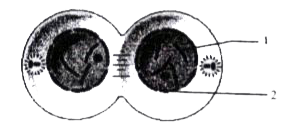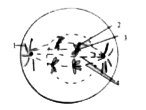In hydrosere, the stages that come before and after the reed-swamp stage are, respectively,
Phytoplankton stage and submerged stage
submerged stage and submerged free-floating stage
submerged free-floating plant stage and marsh-meadow stage
submerged free-floating plant stage and scrub stage
The correct Answer is:C
To solve the question regarding the stages before and after the reed-swamp stage in a hydrosere, we can follow these steps:
1. Understand the Concept of Hydrosere:
- A hydrosere is a type of ecological succession that occurs in aquatic environments. It describes the gradual transition from an aquatic habitat to a terrestrial habitat.
2. Identify the Stages of Hydrosere:
- The stages of a hydrosere typically include:
1. Phytoplankton Stage: The initial stage dominated by microscopic plants.
2. Submerged Stage: Characterized by submerged aquatic plants.
3. Floating Stage: Involves plants that float on the water surface.
4. Reed Swamp Stage: Dominated by reed plants, indicating a transition to a more terrestrial environment.
5. Scrub Stage: The final stage with shrubs and small trees.
3. Determine the Stages Before and After Reed Swamp:
- The stage that comes before the reed-swamp stage is the floating stage.
- The stage that comes after the reed-swamp stage is the scrub stage.
4. Select the Correct Option:
- Based on the identified stages, the correct answer to the question is:
- Submerged free-floating plant stage (before reed-swamp) and scrub stage (after reed-swamp).
Final Answer:
The stages that come before and after the reed-swamp stage are, respectively, submerged free-floating plant stage and scrub stage.
---
- A hydrosere is a type of ecological succession that occurs in aquatic environments. It describes the gradual transition from an aquatic habitat to a terrestrial habitat.
- The stages of a hydrosere typically include:
1. Phytoplankton Stage: The initial stage dominated by microscopic plants.
2. Submerged Stage: Characterized by submerged aquatic plants.
3. Floating Stage: Involves plants that float on the water surface.
4. Reed Swamp Stage: Dominated by reed plants, indicating a transition to a more terrestrial environment.
5. Scrub Stage: The final stage with shrubs and small trees.
- The stage that comes before the reed-swamp stage is the floating stage.
- The stage that comes after the reed-swamp stage is the scrub stage.
- Based on the identified stages, the correct answer to the question is:
- Submerged free-floating plant stage (before reed-swamp) and scrub stage (after reed-swamp).
The stages that come before and after the reed-swamp stage are, respectively, submerged free-floating plant stage and scrub stage.
Similar Questions
Knowledge Check
There are ____stages in PLC.
A6B5C4D3Given below are some of the stages of the hydrarch.
(A) March-meadow stage
(B) Reed-swamp stage
(C ) submerged plant stage (D) Phyotplankton stage
Select the option that represents the correct sequence of these stages.AD→C→E→B→ABC→E→A→B→DCB→D→C→A→EDD→E→C→B→A
Choose the correct identification for the given stage of succession and is procceded by which stage respectively ?

View SolutionStudy the diagram given below which represents a stage during the mitotic cell division and answer the questions that follow:

Mention the stage that comes before the stage shown in the diagram. Draw a neat labelled diagram of the stage mentioned.
View SolutionIdentify the stage which is formed after the fertilisation of the egg by the sperm ?
View SolutionGiven diagram representing a stage during mitotic cell division in an animal cell:

Name the stage that comes just after the stage shown in the diagram. Draw a well labelled diagram of this stage.
View SolutionA: In hydrosere , reed swamp stage is followed by floating plant stage .
R: Sedge meadow stage has amphibious herbaceous plants.
View SolutionThe diagram given below represents a stage during cell division
Study the same and answer the questions that follow :

What is the stage that comes before the stage shown in the diagram ?
View Solution

